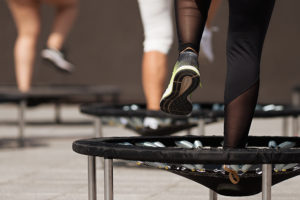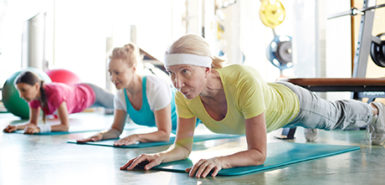
The word “trampoline” makes many people think of either serious gymnasts or the neighborhood’s happiest 9-year-olds.
But plenty of adults are using mini-trampolines, called rebounders, for a bouncy boost to their cardiovascular fitness.
And while experts are leery of larger trampolines because of injury risk, rebounders—especially if used as part of a structured fitness routine—are fun and effective.
“If you’re taking a rebounding class at a gym or following a video as you jump in your living room, these can help get the weight off,” said Spectrum Health sports medicine specialist Matthew Axtman, DO. “It’s going to help build strong bones, strong joints and strong muscles.”
First, he is a big fan of any exercise that inspires people to get moving and trying something different.
“We see so many injuries related to overweight and obesity, as well as early-onset arthritis,” Dr. Axtman said. “So whenever people discover a new workout and do it safely, that’s a positive.”
Second, rebounders are challenging as well as fun.
“When you jump, you use one group of muscles, and when you land, another group counteracts that,” he said. “It’s a really good workout.”
Hard work that feels easy
Rebounders don’t just improve fitness—it’s a workout that feels easier than it is.
A study from the American Council on Exercise put the mini-trampolines to the test. The researchers had 24 fit college students follow a 19-minute routine suggested by JumpSport, a popular brand.
They measured heart rate and maximum oxygen consumption, determining that the workout was demanding, falling just between moderate and vigorous intensity.
But the students’ perceived rate of exertion appeared to be lower. Experts say that’s likely because while the muscles are working hard, there’s less jarring on joints.
And anecdotally, they also think rebounders may improve people’s balance and spatial awareness.
On average, men burned about 12.4 calories per minute while bouncing, and women used up 9.4 calories per minute. That’s about the same as running 6 miles per hour, biking at 14 miles per hour or playing sports like football, basketball or ultimate Frisbee.
But fit college kids aren’t the only ones who benefit. An Italian study, for example, looked at 18 overweight women, with an average age of 38.
After enrolling them in a 12-week fitness routine using rebounders, the women lost weight. But they also lowered their blood pressure and saw improvements in both lipid and glucose levels. They also reported a decrease in joint pain.
It makes sense to find a class to try it first before buying your own equipment. And if you do buy one, make sure to do a little research and read online reviews—some products have been recalled due to safety problems.
 /a>
/a>
 /a>
/a>
 /a>
/a>